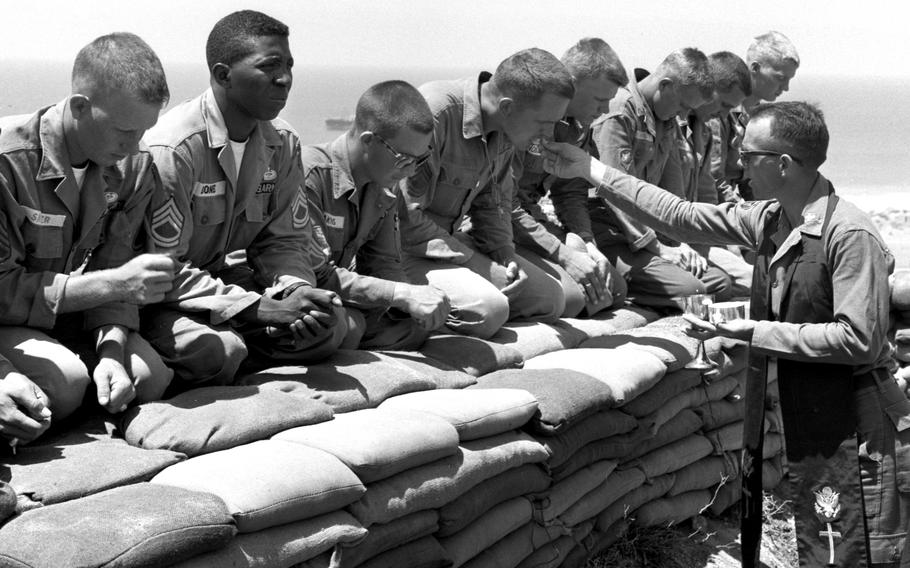
On a hilltop overlooking the Mediterranean near Beirut, Chaplain (Capt.) James Coleman conducts a religious service for soldiers from the 24th Infantry Division. The troops were taking part in Operation Blue Bat, an intervention aimed at protecting the beleaguered Lebanese government. (Merle Hunter/Stars and Stripes)
This article first appeared in the Stars and Stripes Europe edition, July 16, 1958. It is republished unedited in its original form.
BEIRUT — A battalion of American Marines swarmed ashore on the beaches of Beirut Tuesday to spearhead America’s first military intervention in the troubled Middle East.
Under the command of Lt. Col. Harry Add [sic; correct spelling Hadd], of St. Paul, Minnesota, a Korean veteran, the marines moved onto the sandy beach grimly but quietly.
While hundreds of Lebanese swarmed to the beaches for one of the biggest shows they have ever seen, the marines systematically moved of the sand and soon fully surrounded Beirut’s airport.
In the sun set in the Mediterranean behind ships of the U.S. Sixth Fleet which brought them, the marines dug foxholes in the sand and settled down for the night.
Lebanese watching the landing were friendly. The marines came on invitation from President Camille Chamoun, who had called for help after 67 days of disturbances in Lebanon.
A task force of four troopships, two destroyers and the command ship Taconic steamed up within two miles of the shore, sat two hours while landing craft were launched, and then spouted out the combat-garbed marines. The landing took two hours.
Throughout the operation Grumman Hellcats, carrying rockets for low-level missions if needed, roared overhead at treetop level from the supporting carrier Essex.
At the airfield the marines immediately took charge of the control tower, hangers and service installations. Other units deployed surrounding the field. The cordon apparently was decided on as a result of a rebel assault last week that for a time threatened to sweep the field from government control.
Six hours later the airport was reopened to commercial traffic.
In the city itself, it appeared the government and the U.S. command had no intention of bringing marines close to the Basta Moslem quarter where the rebels have their headquarters.
President Chamoun explained the U.S. intervention Tuesday night in a broadcast to the nation.
He said the Arab League and then the United Nations had failed to provide a solution to Lebanon’s crisis. Therefore, he said, “Lebanon decided to invoke Article 51 of the United Nations charter and summon direct aid.
“The destiny of Lebanon is now being determined during these moments of danger,” he said. “May all work for Lebanon.”
Want to delve further into U.S.’ military interventions during the early years of the Cold War? Subscribe to Stars and Stripes’ historic newspaper archive! We have digitized our 1948-1999 European and Pacific editions, as well as several of our WWII editions and made them available online through http://starsandstripes.newspaperarchive.com/